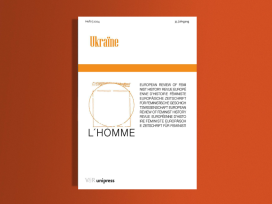Abstracts for L'Homme 1/2007
Giulia Calvi
Kinship and Domestic Service in Early Modern Tuscany. Some Case Studies
This paper focuses on the relationships between servants and family members and on the shifting boundaries that defined both terms. In the sixteenth and seventeenth centuries, weak family members could be confused with servants, and servants could be viewed as part of the family. Affection and obligations towards kin were represented mainly in terms of dependence, deference, and hierarchy, and were therefore rooted in a broad terminology concerning servitude and service. I shall also consider issues regarding the self-fashioning of servant identities, both in objective (i.e. expressing an external point of view) and subjective terms.
Karen Elsa Diehl
Third Persons and Narrative Gemination: Céleste Albaret und Marcel Proust
Céleste Albaret (1891-1984) was in the service of Marcel Proust (1871-1922) from 1913 until the writer’s death. In these years she worked as his delivery boy, cook, maid, secretary, and personal assistant. She had almost unrestricted access to his everyday and working life. When she was interviewed as prime witness for biographies and films on Proust, she cast herself in the role of the perfect and only servant. Her own biography is initially subsumed by the needs of and later by interest in her employer.
When interviewed for her position, Marcel Proust asked whether she mastered the polite form of address – speaking in the third person – and she replied no. The narrative of Céleste Albaret emerges, however, by addressing third persons in a different sense: She gave numerous interviews to Proust biographers and documentary filmmakers. Her life story emerges precariously on the margins. The differences between the story as told by her and the story as told by others lets her emerge indirectly as a first person – albeit speaking to others about her master.
Raffaella Sarti
Zita’s Legend and Servants’ History
In a Filipino television series of the 1960s, the main characters were a good and a bad maid and an Italian medieval mummy kept in Lucca (Italy): these apparently unrelated items are in fact related. The mummy is that of Saint Zita, a thirteenth-century holy maid. The Filipino programme (developed by a Jesuit) was entitled “Santa Zita and Mary Rose” and may be seen as one of the numerous narratives inspired by Zita’s story.
Thus, after showing consistencies and inconsistencies between the results of the study of the mummy and the first medieval life of the saint, the article focuses on the manipulation of the medieval legend (which reflects pauperistic values) over more than eight centuries. According to it, Zita often neglected her domestic duties in order to pray or go on pilgrimages, and even gave alms, without permission, from her master’s goods. Nevertheless, from the Counter-Reformation onwards, Zita was increasingly used to provide maids with a model to follow, and she was increasingly represented as an ideal servant, loyal, and obedient. She was also increasingly presented as the patron of maids, to the point that in 1955 the Pope proclaimed her as such.
This evolution had to do both with the feminization of domestic service and the growing interests of the Church in (lower-class) women in order to guarantee social conservation or even restoration. On the other hand, the fact that, in many countries, Catholic people such as the Filipinas/os were/are well represented among the “new” domestic workers may not be casual: the Catholic Church, indeed, plays/ed an important role in facilitating the process of meeting the demand for domestic labour on a global scale.
Christine Schneider
“When God chooses a soul himself and owns the heart, the creature must step aside². The calling of nuns in hagiography and necrologies (from the Viennese Ursuline Convent, seventeenth/eighteenth century)
The vitae of the Capuchin nun, Clara Francisca of Antwerp (1618-1647), the Italian Benedictine nun Johanna Maria Bonomo (1606-1670), and the Shoeless Carmelite nun Theresia Margaretha Farnese (1637-1684) idealize the life decision to join the nun vocation. In the Viennese Ursuline Convent, Mater Elisabeth, born von Rebenstein, wrote the nun’s necrologies after 1772. The present treatise addresses aspects lifted from these vitae and examines how the stories of the nuns’ calling in the hagiographies differ from the descriptions in the necrologies. These aspects specifically relate to the nuns’ parents’ resistance to the calling; to the nuns’ decision between marriage and celibacy; and to the nuns’ own “inner” resistance against the calling.
Monks, frequently of the same order, composed and distributed printed hagiographic vitae of nuns to a wide audience. Necrologies handwritten by nuns, however, remained in the cloisters. Hagiographies as well as necrologies were written with the aim of vividly demonstrating the model of life and holiness of an exemplary nun and thus encouraging emulation. Impediments such as parental resistance or inner doubts were interpreted as God’s test of the calling. Ultimately, hagiographies depict the calling of a nun as an irresistible act of “being chosen” by God.
Irene Stoehr
Cold Civil War? A German Debate about the Nazi Past and the Women’s Movement: the Case of Gertrud Bäumer 1946-1948
Gertrud Bäumer was one of the most prominent female liberal politicians and leader of the German women’s movement before 1933. For a two-year period after 1945, journalists and politicians from all German occupation zones accused her of having supported the Nazi Regime with her editing activities and publications during the “Third Reich”.
The article contextualizes this campaign against Bäumer within the discourse on the Nazi past in postwar Germany, the beginning of the Cold War, and the reorganization of the women’s movement in East and West Germany. The case study on Gertrud Bäumer draws attention to the long-neglected “domestic” political dimensions of the Cold War in Germany and investigates the usefulness of concepts like “Cold War Culture” and “Cold Civil War” for more than just the category of gender in postwar German history.
Published 11 July 2007
Original in German
Contributed by L'Homme © L'Homme Eurozine
PDF/PRINTNewsletter
Subscribe to know what’s worth thinking about.



